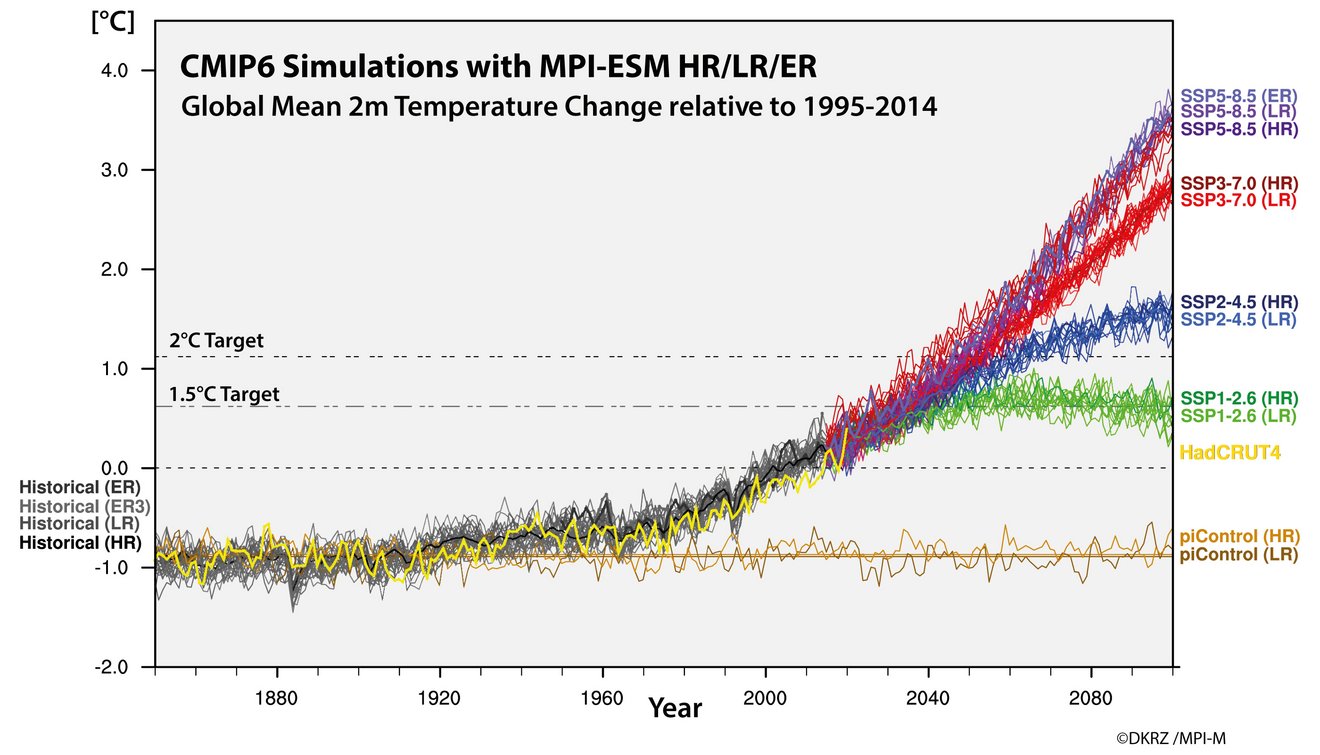New climate simulations for the “Coupled Model Intercomparison Project”
The Max Planck Institute for Meteorology (MPI-M) participated in the recently finalized BMBF funded project DICAD that has coordinated the German contribution to the international CMIP6 archive and supported the national institutes participating in CMIP6 by developing the infrastructure for standardized data preparation and publication. DICAD partners besides MPI-M are the German Climate Computing Center (DKRZ), the German Meteorological Service (DWD), the Institute for Atmospheric Physics at the German Aerospace Center (DLR), and the Free University of Berlin.
CMIP6 consists of three major elements: First, a set of common experiments, the DECK (Diagnostic, Evaluation and Characterization of Klima) experiments and the Historical Simulations (1850 - 2014); second, common data formats, and a federated data storage to facilitate the distribution of model results; third, a set of specific Model Intercomparison Projects (MIPs). The most prominent MIP is the ScenarioMIP, where a range of possible future climate projections is carried out. Scientists of the MPI-M are involved in 15 experimental MIPs, often taking a leading role in formulating the guiding questions and designing the experiments, such as the Paleoclimate MIP, the Radiative Forcing MIP or the Coupled Climate-Carbon Cycle MIP. MPI-M scientists have also co-led novel “diagnostic MIPs” (e.g., Sea Ice MIP [1]) that focus on the evaluation of specific topics and the development of novel tools.
MPI-M participates in CMIP6 with two earth system models: MPI-ESM and ICON-ESM. MPI-ESM [2] is used in different configurations, which differ in resolution and the complexity of the integrated processes. MPI-ESM-HR features higher resolution than the model used for CMIP5, which has led to significant improvements in the representation of ocean and atmospheric dynamics [3]. This configuration is used for historical simulations, future scenarios, and for the Decadal Climate Prediction Project (DCPP). The computationally efficient MPI-ESM-LR (LR – low resolution) is used for many MIPs requiring long integrations or multiple realizations of single experiments. In “LR” the carbon and nitrogen cycles are implemented and vegetation changes are calculated dynamically, which makes it suitable for MIPs with interest in land processes. The High-Resolution MIP analyzes models with the highest possible resolution as part of the EU-H2020 project PRIMAVERA, aiming for example at improved representation of atmospheric circulation and ocean eddies using the MPI-ESM-ER configuration [4].
MPI-M has recently launched its new ICON-ESM, a completely new model system that is based on advanced numerical techniques. ICON-ESM features unstructured grids and is well suited for modern computational infrastructure. In ICON-ESM’s first application as a climate research tool, CMIP6 DECK and historical experiments are presently carried out and the results will be published in the CMIP6 data repository. This anchors ICON-ESM in the community as a novel model system and provides the opportunity to have it evaluated by scientists worldwide.

The DICAD project focused on simulations over the historical period and future projections until the end of the 21st century, for which several new shared-socioeconomic-pathway scenarios (SSP) were provided by ScenarioMIP. The SSPs take into account possible evolutions of greenhouse gas emissions and/or mitigation efforts. MPI-ESM simulates the historical evolution of global mean surface temperature in excellent agreement with the observational record (Fig. 1). This is in part due to a moderate equilibrium climate sensitivity (ECS), a feature that reflects the model’s sensitivity to increased greenhouse gas forcing. MPI-ESM’s ECS is in agreement with the most recent assessments based on observational records, but differs from several other CMIP6 models. Applying four different high-priority scenario simulations, MPI-ESM provides a range of well-separated possible futures for the end of the century. For selected scenarios ensembles of up to ten MPI-ESM simulations were carried out to include information on internal climate variability and uncertainty.
The United Nations Framework Convention on Climate Change “Paris Agreement’s” central aim is to strengthen the global response to the threat of climate change by keeping a global temperature rise this century well below 2 degrees Celsius above pre-industrial levels and to pursue efforts to limit the temperature increase even further to 1.5 degrees Celsius. While the scenario SSP5-8.5 is close to earlier high-emission-scenario estimates from previous CMIPs, applying the new moderate SSP1-2.6 allows the 1.5°C global warming target in the year 2100 to be included in its ensemble spread. SSP1-2.6 requires, however, drastic mitigation efforts.
Ongoing work of MPI-M scientists feeds in knowledge to IPCC AR6 by evaluating processes and feedbacks, or introducing novel methods such as a framework to attribute differences among models in the carbon cycle to physical and biological processes. Other publications document progress from CMIP5 to CMIP6, e.g. improved simulation of sea-ice loss for a given warming [1], or improved forecast skills in higher-resolution DCPP models [5].
Publications:
[1] SIMIP Community (2020) Arctic sea ice in CMIP6. Geophys. Res. Lett., 47, e2019GL086749.
[2] Mauritsen, T., & Roeckner, E. (2020). Tuning the MPI-ESM1.2 global climate model to improve the match with instrumental record warming by lowering its climate sensitivity. J. Adv. Model. Earth Syst., 12, e2019MS002037.
[3] Müller, W.A. et al. (2018) A higher-resolution version of the Max-Planck-Institute Earth System Model (MPI-ESM 1.2 - HR). J. Adv. Model. Earth Syst., 10, 1383–1413.
[4] Gutjahr, O. et al. (2019) Max Planck Institute Earth System Model (MPI-ESM1.2) for the High-Resolution Model Intercomparison Project (HighResMIP), Geosci. Model Dev., 12, 3241–3281.
[5] Schuster, M., et al. (2019) Improvement in the decadal prediction skill of the North Atlantic extratropical winter circulation through increased model resolution. Earth System Dynamics, 10, 901-917.
Contact:
Dr Johann Jungclaus
Max Planck Institute for Meteorology
Phone: +49 (0) 40 41173 109
Email: johann.jungclaus@mpimet.mpg.de
